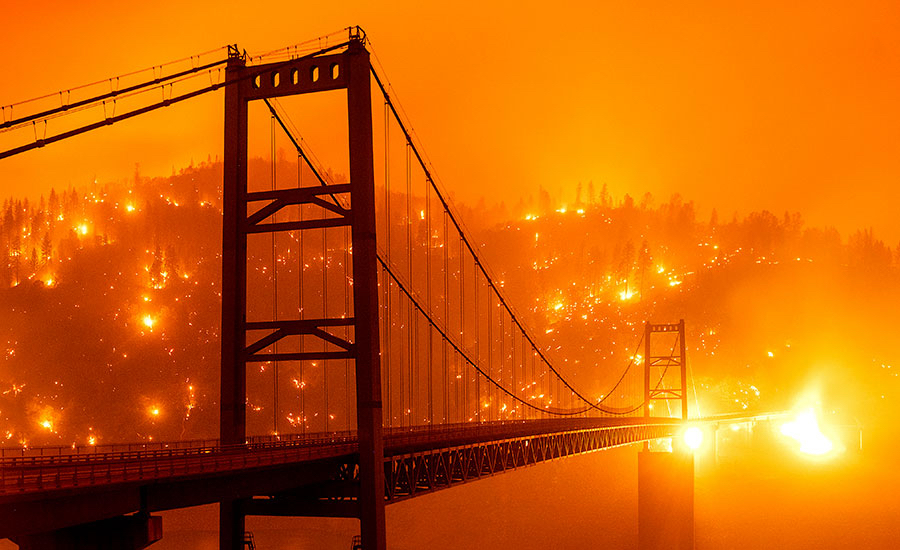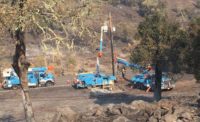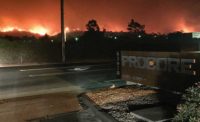As fires rage across California, utility companies issued warnings and preemptively cut power to customers in high-risk areas across the state, with about 14,000 firefighters now battling 28 major blazes.
So far this year, wildfires have burned more than 2.5 million acres across all state fire jurisdictions—a record number, with four months left to go in this year’s fire season, says the California Dept. of Forestry and Fire Protection (Cal Fire).
For much of the state, the National Weather Service issued red flag warnings due to warm temperatures, very low humidities, and stronger winds that increase the risk of fire danger. Fires have caused eight fatalities and destroyed more than 3,300 structures.
Pacific Gas and Electric Co. (PG&E), which provides service to 16 million people in northern and central California, recently turned off power to 172,000 customers in 22 counties due to safety concerns. It based a Sept. 8 Public Safety Power Shutoff (PSPS) on weather and wind forecasts that pose significant fire risk and possible damage to equipment, says the company.
On Sept. 9, more than 3,000 PG&E crew members, by air, in vehicles and on foot, began patrolling nearly 10,750 miles of transmission and distribution power lines that were de-energized for the PSPS event. Once lines are inspected and found free of damage or hazards, PG&E says it will restore customer power.
“The various fires around the state have had some impacts to our infrastructure,” says PG&E spokesperson Jeff Smith. “In some instances, there is rebuilding that will need to take place in order to fully restore customers. This includes installing new poles, transformers etc.”
Restoration for the vast majority of customers impacted by this PSPS event was expected by the end of the day Sept. 9. The shutoff impacted customers in portions of 22 counties: Alpine, Amador, Butte, Calaveras, El Dorado, Humboldt, Kern, Lake, Lassen, Mariposa, Napa, Nevada, Placer, Plumas, Shasta, Sierra, Siskiyou, Sonoma, Tehama, Trinity, Tuolumne and Yuba.
Smith says PG&E is working to improve electric system safety and reduce wildfire risks. The utility made numerous changes after filing for bankruptcy and incurring more than $2 billion in fines due to fires in 2017 and 2018 sparked by its equipment. “Over the past few years, high temperatures, extreme dryness and record-high winds have increased fire risks across the areas we serve in northern and central California,” he says. “Nearly one-third of the electric lines that provide our customers with power are now in High Fire-Threat districts areas.”
To help reduce wildfire risks, Smith says PG&E is meeting and exceeding state vegetation safety standards, hardening the electric system, employing new technologies, and improving its power shutoff program.
Utility Southern California Edison, which serves about 15 million people in a 50,000-sq-mile across central, coastal and southern California, says its Big Creek Generation facility in Big Creek, Calif., suffered unknown damage from the Creek Fire, now burning out of control across nearly 150,000 acres of forest in the Sierra Nevada Mountains.
That fire is currently 0% contained and has destroyed about 300 homes and businesses and forced evacuations, many with emergency military assistance, of more than 350 residents, including utility employees.
One of this season’s largest California fires is the LNU Lightning Complex, affecting Napa, Lake, Sonoma, Colusa, Solano, and Yolo Counties. So far, the fire has consumed 375,209 acres and is 91% contained, with 1,491 structures destroyed and evacuations in place. Meanwhile, the August Complex in Tehama County’s Mendocino National Forest has burned 356,312 acres and is 24% contained.
In Mendocino County, the Oak Fire North, in Willits, Calif., is burning across 863 acres with 10% containment. An evacuation center has been set up, while the fire caused a partial closure of Hwy 1 in both directions near Willits. The Dolan Fire in Monterey County near Big Sur, Calif., is burning 73,089 acres in Los Padres National Forest and is 40% contained.
In southern California, an estimated 8,500 firefighters are fighting six large wildfires, propelled by record heat and powerful Santa Ana winds, which have spurred fires that have burned roughly 175,000 acres so far this year.
In San Diego County evacuations are in effect for the Valley Fire near Alpine, Calif., in the Cleveland National Forest. That fire has burned 17,345 acres and is 3% contained.
In San Bernardino County, the El Dorado Fire is burning 10,574 acres, is 16% contained and has caused evacuations. And in Los Angeles County, the Bobcat Fire north of Duarte, Calif., in the Angeles National Forest is 0% contained and burning 8,553 acres.
Last February, Southern California Edison filed its 2020-22 wildfire mitigation plan with the California Public Utilities Commission (CPUC), a $3.8-billion multiyear effort that aims to reduce risk of fire ignitions caused by utility infrastructure.
“Our wildfire mitigation plan is a comprehensive effort to address the wildfire challenges in high fire risk areas, which represent about 27% of the area we serve,” said Phil Herrington, utility senior vice president of transmission & distribution, in a news release.
The company’s 2020 plan proposes to install at least 700 circuit miles of covered conductor, reducing ignitions caused by objects that contact distribution power lines or conductor-to-conductor contact; add fast-acting fuses at more than 3,000 locations to help interrupt electric current more quickly and reduce the risk of ignitions; conduct enhanced inspections in high fire risk areas; deploy at least 375 weather stations; and actively identify and trim or remove trees that may pose a risk of falling into power lines.
SCE also is piloting new, predictive technologies that will warn of potential equipment failures and allow for proactive responses, including an “open phase” wire-down technology that is a novel way of detecting and isolating wire-down incidents that could pose a wildfire risk, it said.





Post a comment to this article
Report Abusive Comment